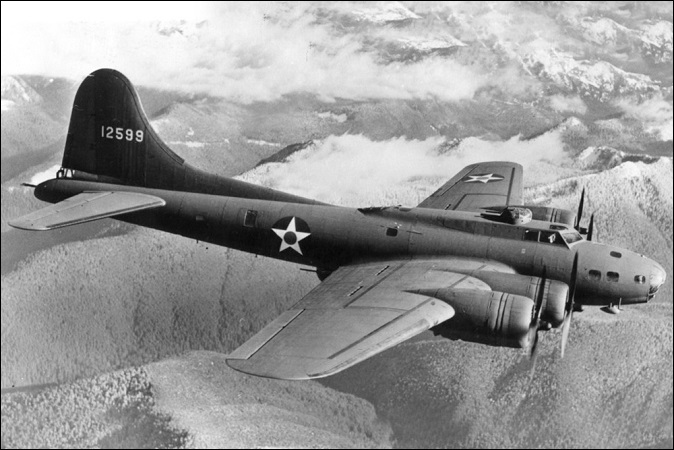● ● ●
The
Japanese attack of Pearl Harbor not only precipitated the
United States into World War II but fixed the nation’s
attention on the Pacific Ocean. The first six months of
America's war, from the Japanese attack on Pearl Harbor (7
December 1941) to the Battle of Midway (4-7 June 1942)
brought with them an unmitigated tale of disaster and
defeat. Though Germany’s declaration of war on the United
States came on 11 December, Wake Island, the Philippines,
the Battle of the Java Sea, dominated the news.
But
long-term strategic considerations dictated that the Pacific
would become a secondary theater of war. The Arcadia
Conference (22 December 1941-14 January 1942) was the first
wartime meeting of the Western Allies, America and Britain.
Arcadia set the template for the coordination of the two
nations’ military effort, and its most important strategic
decision was that the defeat of Germany must be given first
priority.
“Germany
first” demanded a buildup of US military
forces in the United Kingdom, looking forward to an invasion
of France and a subsequent ground campaign in northwest Europe.
This buildup was code-named BOLERO and to facilitate it a US
Army headquarters was established in Britain: United States
Army Forces in the British Isles (USAFBI), later European
Theater of Operations, United States Army (ETOUSA). The air
component of BOLERO called for a US Army Air Forces (USAAF)
deployment of 3,649 aircraft to the UK by March 1943. The
USAAF deployment had two objectives: to ensure that
sufficient air support for an invasion of continental Europe
would be available, and to establish on British soil a force
of heavy, long-range bombers capable of conducting a
strategic air offensive against Germany.
Unlike
the RAF, the American air force was not an independent
branch of the armed forces. The Air Corps remained part of
the Army, though with the establishment of Headquarters,
United States Army Air Forces on 20 June 1941, the airmen
gained a considerable measure of autonomy. For the
duration of the war they shelved their drive to secure for
the air force co-equal status with the Army and Navy. But
they were well aware that the USAAF’s performance in the war
would determine the future of their service.
As in
Britain, the American airmen based their case for
independence on a claim to primacy in future wars. Air
power, striking directly at the enemy’s industrial
infrastructure, would be strategically decisive, relegating
the other armed forces to secondary roles. In the interwar
years, the American version of this strategic air power
doctrine came to be based on the concept of daylight
precision bombing. And in early 1942 as the air deployment
to the UK got underway, the USAAF believed it had the
weapons and technology necessary to make that concept
effective.
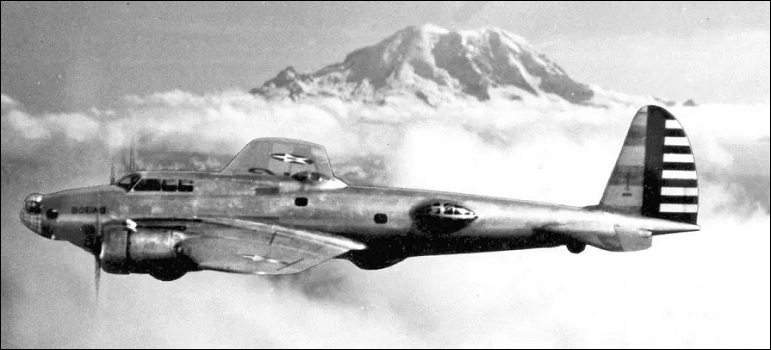
The first B-17: Boeing's Model 299 (The
Boeing Company)
The
prototype Flying Fortress—Boeing's Model 299—made its first
flight on 28 July 1935 and demonstrated such potential that
despite its later loss in an accident an Air Corps order for
thirteen improved YB-17s followed in 1936. These aircraft
were used for test and evaluation purposes pending Air Corps
adoption of the type. Once declared operational the YB-17
was redesignated as the B-17A. Ten more with detail
improvements, designated B-17B, were ordered in 1937 with
the intention of establishing two heavy bombardment groups,
one on each US coast. In July 1940 an additional 512 B-17s
were ordered and by 7 December 1941 there were some 200 in
USAAF service.
As to be
expected with such a technologically advanced aircraft, the
early B-17s exhibited various teething troubles. Twenty
B-17Cs were provided to the RAF via Lend-Lease but due to
inadequate crew training, maintenance problems, and design
flaws they proved disappointing in service. One major weak
spot was the defensive armament. None of the B-17C’s five
machine guns were mounted in power-operated turrets, they
were prone to jamming, and there was no tail gun.
Fortunately, however, Boeing had been at work on a major
redesign, and this became the B-17E. It had a new tail
assembly for improved flight stability, a tail turret with
twin caliber .50 machine guns, power-operated dorsal and
ventral turrets with the same armament, and numerous other
improvements. The B-17E was the first mass-produced version
of the Flying Fortress. Over 500 were built and it was
followed by the B-17F with further improvements. Between
mid-1942 and late 1943, these two models equipped most of
the USAAF heavy bombardment groups in the UK.
Pinpoint
bombing performance was to be assured by the top-secret
Norden Mk. XV tachometric bombsight.
The Norden employed an analog computer that
recalculated the bomb impact point based on changing flight
conditions, coupled to an autopilot that that made rapid and
accurate course corrections. Together, these features
promised unprecedented accuracy for daytime bombing from
high altitudes. In prewar tests the Norden achieved a
circular error probable (CEP) of 75 feet, meaning that it
could place bombs within a circle of that diameter. The Air
Corps believed that the Norden would enable heavy bombers to
make precision attacks on such targets as ships and
factories from high altitude.
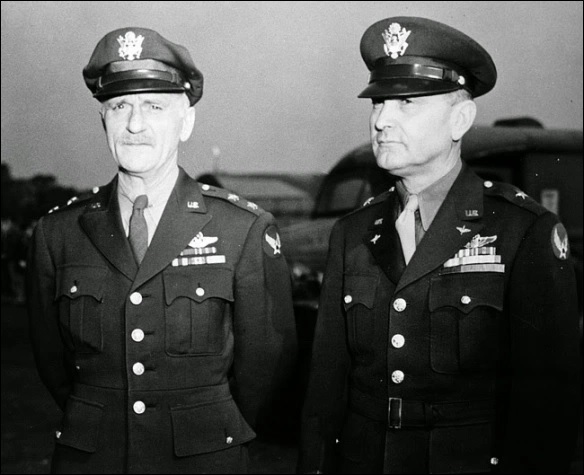
Major General Carl Spaatz
(left), commanding Eighth Air Force, and Brigadier General
Ira Eaker, commanding VIII Bomber Command (US War
Department)
The
USAAF formation that would conduct the strategic air
offensive against Germany, the storied Eighth Air Force, was
activated on 28 January 1942 at Savannah Army Air Base,
Georgia. The Eighth was not originally earmarked for
Britain; it was to be the air component of Operation
GYMNAST, the proposed invasion of North Africa. When this
was postponed (later to be revived as TORCH in November
1942), it was decided that the Eighth would go to Britain
instead. There, the groundwork for a major deployment of
American airpower was being laid by Brigadier General Ira C.
Eaker, the commander-designate of VIII Bomber Command. He and a small staff
had arrived in Britain on 8 February 1942 and immediately
set about the gargantuan task of creating the infrastructure
necessary to support a strategic air force.
In
this the Americans were greatly assisted by the RAF. The
cooperation between the allied air forces is one of the
outstanding success stories of World War II, and in those
early days the RAF was unstinting in its support of the
fledgling American effort. Eaker established excellent
relations with Air Chief Marshal Sir Charles Portal, the
Chief of the Air Staff, and with Air Marshal Sir Arthur
Harris, Air Officer Commanding-in-Chief, Bomber Command. They saw to
it that the Americans were provided with everything from
billets and rations to clerical, maintenance and
communications support pending the establishment of the USAAF logistical base. To prepare for the reception of the
Eighth Air Force, 127 airfields, either already in existence
or to be constructed, were identified. Seventy-five of these
were earmarked for the Eighth’s heavy bombardment groups.
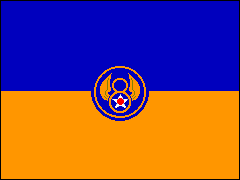
Distinguishing Flag of the
Eighth Air Force
The
group, consisting of a headquarters squadron and three
flying squadrons with eight, later twelve, aircraft each was
the USAAF’s basic unit. In Britain, each heavy bombardment
group would be allotted a primary and a satellite airfield.
Sixty-six of these were to be ready by March 1943. For the
initial American deployment, eight airfields already under
construction for the RAF were made available.
While these preparations in Britain were underway, the
Eighth Air Force was being reorganized for its new mission
and prepared for deployment. This was the responsibility of
Major General Carl Spaatz, the commander of the Eighth since
5 May 1942. The Eighth’s major subordinate units were VIII
Bomber Command, VIII Fighter Command, VIII Composite Command
(responsible for training) and VIII Service Command
(responsible for logistics). A large number of combat units
were listed for future assignment to the Eighth, but
initially it had only the 1st and 31st Pursuit Groups, the
97th Bombardment Group (Heavy) and the separate 5th Photo
Reconnaissance Squadron. Later two more pursuit groups—by
then redesignated as fighter groups—and two more heavy
bombardment groups were added.
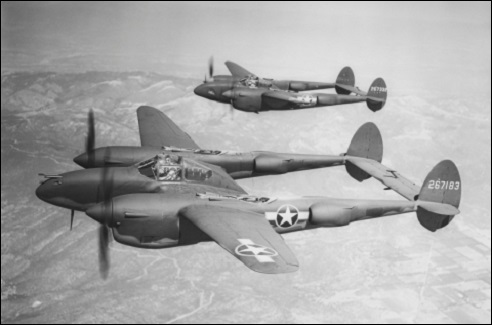
Early production P-38 fighters like these
equipped two of the Eighth Air Force's four initial fighter
groups (US Air Force History & Museums Program)
The
ground echelon of the Eighth moved to Britain mostly by sea,
but the aircraft themselves flew directly from the US. There
were three routes, all originating from Presque Isle, Maine,
with intermediate stops at Goose Bay, Labrador, Gander,
Newfoundland, Greenland or Iceland. Despite the perils of
such long flights, especially for fighter aircraft, the
movement was completed successfully with only 5% losses—half
what had been forecast. By August 1942 386 aircraft—164
P-38s, 119 B-17s, and 103 C-47s—had arrived in Britain. Only
the two fighter groups equipped with P-39s did not fly their
aircraft across the Atlantic; such a flight was considered
too dangerous for the single-engine Airacobra. Instead, the
two groups were provisionally equipped with Spitfires upon
their arrival in Britain.
So the Americans
arrived: in small numbers initially, and it would be some
time before the first units were ready for combat. Aircrew
required additional training and familiarization with
European conditions, the Eighth Air Force’s ground
organization had to be perfected, there were thousands of
details, from high priority to trivial, that demanded
attention. This was the work done by General Eaker and his
staff between February and August of 1942, and it set the
stage for the assembly of a mighty aerial host.
● ● ●
